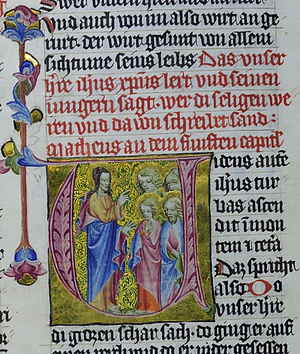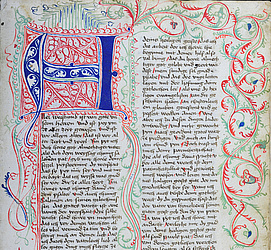The Word of God in German – Annotated Critical Hybrid Edition
For the first time, the critical edition of the Austrian Bible Translator’s works makes texts accessible that are essential for understanding and interpreting the Late Middle Ages, providing an essential contribution to European self-perception.
So far we are acquainted with comprehensive translations of the Old Testament (Alttestamentliches Werk, formerly known as Schlierbacher Altes Testament) as well as of the New Testament Gospel Works (formerly known as Klosterneuburger Evangelienwerk). Connected to these manuscripts are among others German-language prefaces and a Latin apologia as well as several treatises, among them in particular two Adversus Judaeos treatises, a small book on the Antichrist and another one on the Last Judgement.
There are numerous manuscripts and fragments of individual parts of the œuvre handed down, some of them also art-historically relevant. Of the Psalm Commentaries alone, so far 65 textual witnesses are known, of the Gospel Works 27 complete manuscripts and fragments. There are also early parallel versions of some Gospel Work writings, origin and authorship of which still need to be determined.
Complex Conditions of Tradition
In recent decades the unity of these German texts as an œuvre as well as their significance for intellectual history has been recognized. That, in spite of their great significance, they have not been edited so far, can be attributed to the peculiarities of the authorship and the complex conditions of tradition. After the unity of various works had become evident during the 1930s, only latest research was able to reconstruct the complete work. While being copied, the comprehensive and intensively received texts differentiated into versions, excerpts and secondary alterations. Their editorial representation presents a particular challenge that can be met by a group of editors only. The first question arising relates to the author and his complete work.
Edition and Commentaries
One of the tasks to be met will be to determine and comment on the many sources used by the Austrian Bible Translator for his work. The interacademic project of the research groups at the Bavarian Academy of Sciences and Humanities (Bayerische Akademie der Wissenschaften, BAdW) and the Berlin-Brandenburg Academy of Sciences and Humanities (Berlin-Brandenburgische Akademie der Wissenschaften, BBAW), under the tutelage of Prof. Dr. Freimut Löser at Augsburg University (Universität Augsburg), Prof. Dr. Jens Haustein, University of Jena (Universität Jena) and Prof. Dr. Martin Schubert, University of Duisburg-Essen (Universität Duisburg-Essen) will search for other textual witnesses, identify, publish and comment on texts during four module phases of three years each.
As a first step, since it was already sponsored by the German Research Foundation (Deutsche Forschungsgesellschaft DFG), the edition of the Austrian Bible Translators Old Testament Works will be published in 2019. At the same time, the teams in Augsburg and Berlin will engage in researching, analysing and interpreting sources and history of the Gospel Works (Evangelienwerk), followed by making the Psalm Commentaries accessible as a next step.
Digital Edition
Besides the printed version of the edition, one of the project objectives is the realisation of a digital platform, making the various stages of the edition’s development available to the public, including transcriptions, version editions, unannotated edition texts and of course the final editions. Also digitisation of not yet available images of manuscripts will be financed from project funding and published online in accordance with the libraries. This way the project also offers theologians, historians, cultural historians as well as philologist in various fields an intriguing basis for research.
The Old Testament Work (Schlierbacher Altes Testament)
The Old Testament Work, in science also known as the Schlierbacher Altes Testament, is now named after the place where its first known manuscript was found. It represents an edition of large parts of the Old Testament based on the Latin Vulgate.
During the first project period (2005–2012) the originally scheduled Old Testament part including Genesis, Exodus, Tobias, Hiob and Daniel was enlarged upon with Proverbia Salomonis and Ecclesiastes because of new texts found. The Old Testament text input has been completed (Genesis, Exodus, Tobias, Hiob, Proverbia Salomonis, Ecclesiastes, Daniel) as well as the input of the treatise texts.
The now completed critical apparatus includes all differing reading versions, consistently citing the corresponding Vulgate passages. It quotes the originals used by the Austrian Bible Translator for his glossaries, almost exclusively found in the Glossa Ordinaria. Based on this textual foundation it will be possible in future to perceive and research the Austrian Bible Translator in his Old Testament Work as the editor of the Glossa Ordinaria.
The edition will be published in 2019. It will conclude the project part funded by the German Research Foundation (Deutsche Forschungsgesellschaft DFG), complemented by the necessary extension. The edition will be printed within the framework of the project.
Gospel Works (Klosterneuburger Evangelienwerk)
During a research period of about six years the Austrian Bible Translator’s Gospel Work is being made available and commented.
So far it has been known as the Klosterneuburger Evangelienwerk, named after the place both complete manuscripts were found in.
The prose translation of the canonical gospels, created around 1330, also includes the apocryphal, yet for the Middle Ages very important Gospel of Nicodemus as well as numerous other vernacular legends and Apocrypha.
The Austrian Bible Translator not only translates and comments on the different sources, if necessary, he also harmonises and arranges them in a new order.
This way the stations in the life of Jesus, told in the respective gospels and Apocrypha are merged into one text. The resulting harmony follows the chronology of the life of Jesus but is also structured in accordance with the pericopes and can therefore also be read in individual parts.
Exceptional Editorial Challenge
Soon after the Gospel Work was written the text was distributed in an edited version. edited. Whether this can be attributed to the Austrian Bible Translator himself as well or to another Anonymous, can not be determined (yet) but the first assumption seems quite probable. Researching these stages of textual tradition is one of the special editorial challenges: the necessity to develop version synopses and to make the Gospel Work’s interesting as well as complex conditions of tradition transparent and available to research.
The interacademic project now searches for other textual witnesses such as manuscripts and fragments which pass on the Gospel Work, then identifying, publishing and annotating the texts. The 27 textual witnesses known so far are more closely defined, the reference manuscripts of both editorial stages transcribed. All in all, the text to be critically edited and commented comprises about 1600 manuscript pages (800 folios).
Das „Evangelienwerk” in der Handschrift Gö
In der digitalen Editon werden die Transkriptionen sämtlicher Textzeugen des „Evangelienwerks” beider Fassungen publiziert. Geplant ist die dynamische Präsentation der Handschriften und ihrer Transkriptionen.
Unter www.bibeluebersetzer-digital.de stehen für das „Evangelienwerk” seit Dezember 2022 die Digitalisate und Transkriptionen der Handschriften und Fragmente zur Verfügung. Die Edition des „Evangelienwerks” nach der angenommenen Erstfassung *Gö ist seit Januar 2024 zugänglich.
The Psalm Commentaries
Following edition and commentary of the Gospel Works there are plans for another six-year period when the widely broadcast Psalm Commentaries will be critically edited and commented on. This will include the 65 textual witnesses known so far, among them three versions with different prefaces each. The text to be edited will comprise about 1600 manuscript pages (800 folios) as well.
The widespread distribution of the Psalm Commentaries can be attributed to the popularity of vernacular psalm translations. The Psalter represents the basic literary work of the Middle Ages, used for learning how to read and write, serving for private prayer as well as a basis for the Liturgy.
Written for People Living Outside Monastery Walls
Vernacular Psalter exegeses are documented for the German-language Middle Ages since Notker III. of St. Gallen. While he produced his interlinear translation and commentary in particular for his fellow brothers in the monastery, the Austrian Bible Translator decidedly wrote for the people outside monastery walls.
The Psalter holds a prominent position with the Austrian Bible Translator. It is possible, that the first of various versions represented the source text for his large-scale Bible translation, indicated by numerous quotations from the Psalm Commentaries in the Gospel Work and the apologies. In comparison with other medieval Psalter translations the Austrian Bible Translator’s achievement becomes even more obvious. Unlike many of his predecessors and successors he frees himself to a large degree from the Latin textual guidelines, finding new ways of linguistic mediation.
Alignment with the Contemporary Psalm Commentaries of Nicholas of Lyra
Verse-by-verse the Austrian Bible Translator is commenting the Psalms, referring to, as far as we know today, the contemporary Psalm Commentaries of Nicholas of Lyra OFM, even while they were still in the process of being written. The traceable use of this source and the date of the text creation in 1326, led to recognizing the error that was made by originally attributing the authorship to Heinrich von Mügeln, who was mentioned as author in the oldest manuscript from 1372.



![[Translate to English:] Schaffhausen, Stadtbibliothek, Gen. 8, fol 8v Gospel Works, winged ox (fol. 8v)](/fileadmin/_processed_/8/7/csm_04_SchaffhausenStadtbibliothekGen8fol008v_medium_2600112bbb.jpg)

